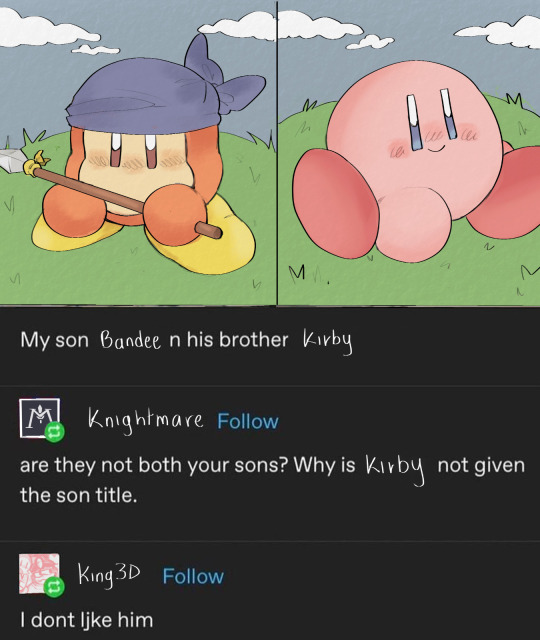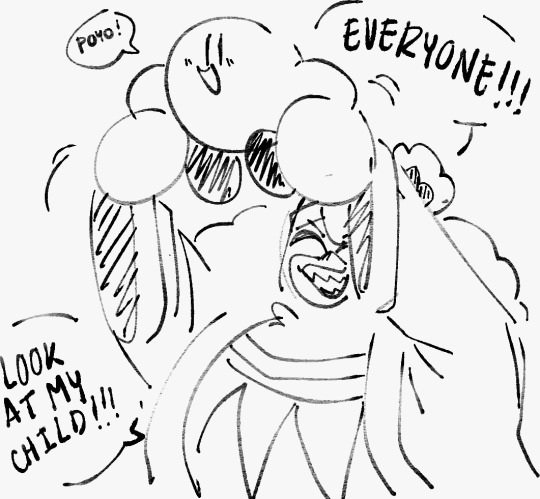#you know how gay penguins adopt eggs that are abandoned by their parents
Text

Bandee is the favorite son (actually is Kirby but it's a secret)
Day 6 of drawing kirby shitpost for every day of October
Bonus old sketch:


#kirby#kots#kirby of the stars#kirby fanart#hoshi no kirby#king dedede#meta knight#bandana waddle dee#most of the shitposts from now on are probably going to be about dedede and Kirby#i just like their relationship very much#dedede actually loves Kirby so much#have you ever thought about the fact that Kirby will outlive Dedede by probably a fucking lot#maybe that would be the time Kirby learns about the concept of death for the first time#i think about them a lot#you know how gay penguins adopt eggs that are abandoned by their parents#dedede is that gay penguin#and Kirby is his adopted egg#and Kirby's parents are the concept of chaos itself so maybe it didn't have a choice#I'm not sure where Bandana enters the equation#specially because i see Bandana as having a childhood crush on dedede so being his dad would be weird#my hc is that waddle dees are lowkey hivemind-like and all waddle dees go through a phase where they have a crush on dedede#and bandana has trained himself to be more resistant to everyone's combined feelings#the burden of being the representative of waddle dees
452 notes
·
View notes
Text
Gay Animals Part II: Electric Boogaloo, The Science of Gay, and You
Before I start this article off I’d like to lay a disclaimer: The reason behind why people are queer isn’t very well understood, but all science tries to do is understand the “why” of things and passes no judgment, regardless of the cause. If science said the homosexuality was 100% caused by watching too many cartoons (spoilers: it’s probably not) that information makes you no less you and it shouldn’t affect how you feel about yourself. But, as we will see, homosexuality is not only something incredibly prevalent in the animal kingdom, but is as accepted as any other trait an individual can express.
So, with all that being said, this article will deal with homosexuality, genetics, possible environmental factors, and its possible evolutionary benefits in nonhuman animals. Because the human brain is so much more complex than anything we’ve ever seen, and we still don’t know most of its secrets, it’s important to remember that what might be true for rams, penguins, or even our close relatives like bonobos, is not necessarily the case for humans. Nor should we look at other animals in a human-like manner. For instance, it’s entirely likely that gay animal couples pick up the slack for parents who abandoned their children. We can’t and shouldn’t look at them through a human filter, because it would be impossible to tell if they love each other as human couples (hopefully) do, or if their union is purely survival based. Humans might be the only creatures able to feel love, or it might be more prevalent that we are aware. Whatever the answer, it doesn’t matter here. All I will be doing is going over some of the facts that scientists know, and why this would matter to animals in the wild.
So if any of this makes you uncomfortable, then please skip this post. If you feel I’ve offended you somehow then please DM me and I’ll try to amend this the best I can. Otherwise please click the read more below.
Now homosexuality is kind of ambiguous of a term, and many scientists have conflated it with hermaphroditism, so to avoid confusion I am going to define homosexuality in the animal kingdom in two ways.
Same-sex, long-term courtship.
These are same-sex couples that act towards each other as a heterosexual couple would for at least one mating season.
Homosexual intercourse.
This can last for as long as one night of passion, or be a continuous trait in an individual.
I’m also going to consider bisexual animals on the homosexual spectrum.
PART I: The One With the Genes
Arguably one of the most powerful aspects of biology is evolution, and a key principle in evolution is detrimental traits are less likely to get passed down than traits that make it easier to survive and reproduce. So why is it then that homosexuality, a trait that seemingly provides no advantage to reproduction, is so prevalent not only in individuals but throughout the animal kingdom? If we assume that homosexuality is genetic (and there is good cause to believe that) then shouldn’t that gene cease to be passed down?
Most times the answer is yes, but sometimes if a gene benefits a whole population it will continue, even if some individuals are negatively affected by it. According to one study male homosexuality actually persists because of this very reason, not because it benefits the males, but because it benefits the females. According to the authors, homosexuality is more common in lineages with females who have high androphilic tendencies, that is, a high attraction to males. Now in males, this gene will manifest as a what appears to be homosexuality, but in females this heightened androphilia will manifest as an increased sex drive, making up for the male carriers.
This, of course, does not account for female homosexuality. Nor does it take into account possible environmental factors we’ll get into later. But it is important to highlight how evolution and nature look at traits. Under normal circumstances, unless a trait is highly deleterious (deadly to the individual) there won’t be enough pressure to remove it. But are these genes deleterious anyway? We’ve seen that they may play an important role when not being expressed as homosexuality, but it could play an equally as important role in homosexual animals.
PART II: The One With the Homosexual Helper
Animal preference and motivation are not always the same as it is in people. Swans mate for life. But is that because it makes it easier for them to find a mate in the future, or is it because they can feel a complex emotion like love? It’s impossible to say, so it’s impossible to know why animals do a lot of things. “But goddammit we’re going to try”, science said.
Take the humble penguin. In my last post, I wrote about how gay penguins will frequently “adopt” orphaned eggs and raise them as their own performing all of the same functions as a heterosexual couple would. Why then, waste resources raising something that’s not your own child?
According to Darwin, it’s not just individuals who evolve to protect their lineage, but groups that evolve to protect their species. This is largely the basis for theories on why altruism exists and can be applied here as well. Afterall, a homosexual couple is never going to produce a child, and if an egg or a baby is without a parent the option is left to die the population as a whole will have lost a child. But if a couple unable to conceive their own adopts it, then that is a net gain for the population as a whole. Thus, the population that keeps these genes that reciprocate this kind of altruism is more fit to survive than a population that doesn't. And the adoption phenomenon can often be seen in non-homosexual individuals as well, but it demonstrates a good example of how altruistic genes can help a species grow even at the cost of fitness to the individual.
PART III: The One With the Sexual Leverage
Nature is a fickle mistress, and she does not subscribe to one dogma. Sexuality, while predominantly used for creating the next generation, has been appropriated by many species as a form of leverage, bonding, the assertion of dominance, and even used to take the place of an all-out brawl. So it’s no surprise then that homosexual acts are used in a similar fashion. This is also where the motivating factors of homosexuality moves away from a possible genetic or natural cause and towards as more psychological reason. Take, for instance, the bonobo. This species seems to be functionally bisexual, using sexuality for control rather than attraction. In one instance a bonobo might have sex with their opposite gender for the reason most animals would, to make a baby. In the next instance, that same ape might get into a disagreement with an ape of the same gender. These two apes, instead of fighting, will use sex as a way of diffusing and diverting attention from the disagreement. And yet these two acts of sexual intercourse are entirely unrelated, and likely evolved for those specific scenarios.
And this is true in plenty of other animals as well, dogs will mount other dogs regardless of gender to show dominance. Marmots mount other marmots as a form of bonding. Dolphins will have sex with the same gender for fun, and then sex up the opposite gender for reproduction. The common trend it seems is that animals who are more sexually fluid, or bisexual, leverage their sexuality for personal gain, whether it be bonding, pleasure, or something else. While animals who remain uniquely homosexual have a more positive effect on the population’s fitness as a whole.
PART IV: The Scientific Community and Homosexuality: Do They Know Things? What Do They Know? Let’s Find Out.
Finally, I’d like to conclude with some talk about where scientists think homosexuality falls on the nature/nurture spectrum. Studies have shown identical twins are more likely to both be gay than fraternal twins, meaning that sexuality is almost certainly somewhat controlled by genetics, and this, of course, makes sense based on what we’ve seen and I’ve just talked about. Conversely, there are hormonal, as well as environmental, factors that may also contribute to homosexuality.
While most researchers agree that sexuality is innate, something that develops at an early age, possibly before cognition and doesn’t change throughout one’s lifetime, they are still hard pressed to figure out why. While it is unlikely that parenting has any effect on sexuality, parents can still influence sexuality. Several studies have shown that the each child born in a family line has an increased chance of being homosexual. For instance, the 7th son will be more likely to be gay than the 2nd son, etc. This is suggested to be likely due to prenatal hormones, but the exact reason is yet unknown.
And while homosexuality is innate, homophobia is not. In fact, while it’s likely every species has some homosexual members to it, humans are the only species with homophobic members. Much of what we know about homosexuality is stifled by human biases and irrational fears, something we’ll go over in the last part of this series.
CONCLUSION
So why does knowing the cause of homosexuality matter? Well besides intellectual curiosity, something that science is very fond of, it’s important to have facts. Over the past 50 years, we’ve seen huge leaps in rights for minorities, and that is a change that is still happening. As a society, we’re seeing growing pains. Where many embrace the change towards tolerance with opened arms, either because it affects them directly or because they have empathy for their fellow man, many are resistant to change something that they’ve never seen as broken. So it never hurts to have some objective fact reinforcing a new idea, and where better to get that objectivity than science.
#bioblog#gay animals#gay pride month#homosexuality#animals#before your send me your hate mail#I am asexual and biromantic
3 notes
·
View notes